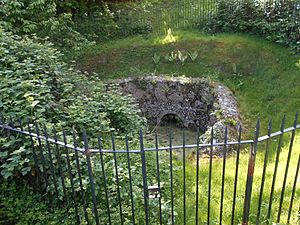St Augustine's Conduit House facts for kids
Quick facts for kids St Augustine's Conduit House |
|
|---|---|
 |
|
| Location | King's Park, Canterbury |
| OS grid reference | TR 159 580 |
| Built | 12th century |
| Designated | 30 October 1972 |
| Reference no. | 1014577 |
| Lua error in Module:Location_map at line 420: attempt to index field 'wikibase' (a nil value). | |
The St Augustine's Conduit House is an exciting old building in Canterbury, Kent, England. It's like a special water house from the Middle Ages, built to bring clean water to St Augustine's Abbey nearby. Today, it's an English Heritage site, which means it's protected as an important historical place. It's also a "scheduled monument," meaning it's a very important archaeological site that is legally protected.
Contents
What is a Conduit House?
Imagine a time long ago, before modern plumbing! In the Middle Ages, people often got their water from rivers or streams. But these could easily get dirty. To make sure places like monasteries had clean water, they built special structures called conduit houses. These houses collected fresh spring water and sent it through pipes to where it was needed.
How St Augustine's Conduit House Worked
This particular conduit house was built around the mid-1100s. It was placed on a hillside facing west. Why there? Because there were natural springs nearby!
- Collecting Water: Water from these springs flowed into the conduit house. It came through four main tunnels, which were fed by many smaller channels. All this water collected in a large tank inside the building.
- Building Design: The conduit house is shaped a bit like an octagon (an eight-sided shape). It measures about 7 meters (23 feet) from north-east to south-west and 4.75 meters (15.5 feet) across. The walls that are still standing are about 3 meters (10 feet) high.
Water Delivery to the Abbey
Once the water was collected, it traveled downhill to St Augustine's Abbey. It flowed through a lead pipe that was about 3 inches (7.6 cm) wide. At the abbey, there might have been a tall water tower. This tower would have helped send the water to smaller tanks located in different parts of the monastery, making sure everyone had access to clean water.
History and Changes Over Time
This old building has seen many changes over the centuries!
Later Uses and Repairs
In 1733, a man named Sir John Hales owned the conduit house. He allowed the city of Canterbury to use its water to help with their own supply. It's thought that he made some changes to the building, like dividing the water tank and adding a new roof with two curved sections.
More repairs and updates happened in the 1800s, including rebuilding the roof again.
The Roof Collapse and Discovery
Sadly, the roof of the conduit house fell in February 1988. Later that year, archaeologists from the Canterbury Archaeological Trust carefully dug around the site. Their work helped them learn a lot about how the building was first put together.
Images for kids


